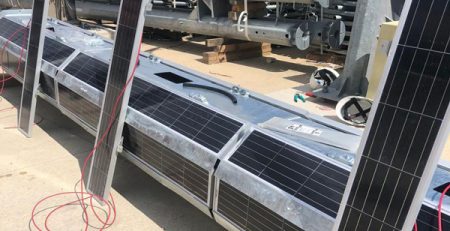能源存储增长缓慢但广泛 2019, 明年翻三倍
For battery power, 这是部署量第五高的月份,而电池容量是第三高的月份.
研究小组指出 32% 上图中 19 年第二季度部署的兆瓦增长, while below they show 59% growth over the prior quarter in terms of megawatt-hours deployed. The 59% was driven by longer duration in front of the meter installations by utilities. Future projects have already signed much longer hourly ratios, with certain developers seeking 24 hour solar – so expect that battery capacity may outgrow battery power.
The document saw the various markets grow in their own patterns. Residential energy storage has consistently grown since a late last year slump due to supply challenges. More growth is projected to come from California due to the power safety shutdowns. The commercial sector has seen two straight months of pull back after a big Q4-Q1’19, no reason was noted. Of course, the wild card is the utility scale sector – whose peaks historically set the record months.
State wise, the Massachusetts SMART program was the quarter’s clear leader for front of the meter deployments at 58 MWh, with Vermont (always smart with storage) 和, surprisingly to this author, Arkansas tied for second place at 24 MWh each. California, Hawaii led the residential energy and commercial energy storage markets with with roughly similar volumes each deployed. Considering California is over 25 greater than Hawaii, but only outpacing by 4-5X, its pretty obvious Hawaii is making some serious moves.
Going forward is where the real story is, and this has been growing as fast as the factories can be built really. From 2019 into 2020, the market is expected to triple, then going from 2020 into 2021 the market is projected to more than double. Before, by the end of 2024, another doubling will occur – bring us to 12X growth over this year.
The market will be worth $645 million this year, before hitting almost $2 billion next year, more than doubling in 2021 到 $4.2 billion, then cruising up to $5.4 billion in 2024. Front of the meter will make up a most of that market, however, due to its higher cost per unit will itself become a billion dollar market in 2021.
Wood Mackenzie doesn’t offer pricing on on battery packs, only showing the above US market money spent. 然而, Bloomberg New Energy Finance recently published that battery pack prices have fallen to $156/kWh, and this author has seen bids in the $350/kWh range delivered in a shipping container for smaller volumes.
Bluesun has successfully installed much energy storage systems for residential use. High performance 400watt perc solar panel with centralized energy storage inverter.


